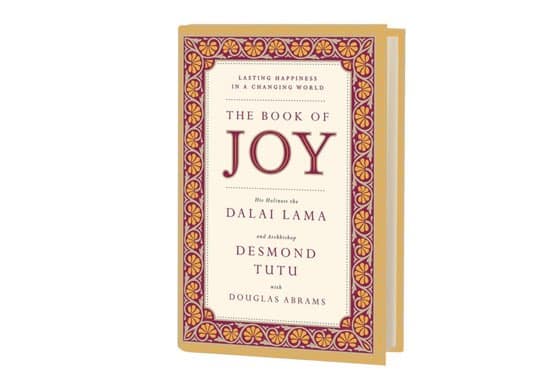July 31, 2018
The Book of Joy by His Holiness the Dalai Lama and Archbishop Desmond Tutu with Douglas Abrams (Penguin Random House, NY, 2016)

In their book about joy, Douglas Abrams interviews His Holiness the Dalai Lama and Archbishop Desmond Tutu over the course of a week they spent together in Dharamsala, India, deepening their friendship and celebrating their birthdays. They share what two people from very different backgrounds have learned about the nature of joy over the course of their long lives.
They remind us that joy is in fact our birthright and is even more fundamental than happiness. They share their hard-won wisdom of how to live with joy in the face of life’s inevitable sorrows. Together they explore how we can transform joy from a fleeting feeling on one day of the week into a lasting way of being. This is neither a Buddhist nor Christian book, but a universal book supported not only by opinion or tradition but also by science.
The book is built around the authors’ insights on the nature of true joy, the obstacles to joy, and the eight pillars of joy. As research conducted at the Institute of Neuroscience and Psychology at the University of Glasgow, Scotland suggests, there are really only four fundamental emotions: fear, anger, sadness, and joy or happiness. Exploring joy is nothing less than exploring what makes human experience satisfying.
The Dalai Lama shares how creating more joy depends on the attitudes, perspectives, and reactions we bring to situations and to our relationships with other people. Events are going to happen that create fear, anger, and sadness within us. They are part of the warp and woof of life. But they need not be the determinants of who we are. We can use these things that are seemingly negative for a positive effect.
One example that is given is how Nelson Mandela’s 27 years in prison helped him become more magnanimous and compassionate, expanding his capacity as the first black president of South Africa to put himself “in the shoes of the other”.
A second example is how the Dalai Lama, after the Chinese invasion of Tibet in the 1950s pushed him into exile, has come to meet new people, learn new things, grow in his spiritual life, and enlarge his empathy and compassion in seeing that he and the Tibetan people were not alone in their suffering. “The way we heal our own pain is by turning to the pain of others,” he says. “And the more we turn toward others, the more joy we experience, and the more joy we experience, the more we can be . . . a reservoir of joy, an oasis of peace, and a pool of serenity that can ripple out to those all around you.”
A study by sociologist Lynn Smith-Lovin has found that the number of close friends people report having has reduced from three to two. While we might have hundreds of Facebook friends, our true, close friends are decreasing. One in ten people said they had no close friendships at all.
Archbishop Tutu says he hopes this book will awaken in us how deeply we are wired for complementarity, togetherness. “You need other people to be human. That’s why when they want to punish you they put you in solitary confinement. Because you can’t flourish without other human beings. They give you things you cannot give yourself, no matter how much money you have.”
Joy is the reward, he says, of seeking to give joy to others. When we show love to others, do things for others, we will experience a deep joy that we cannot get in any other way.
A significant portion of the book is filled with the authors’ humane reflections on eight pillars of joy. Four relate to qualities of the mind: perspective, humility, humor, and acceptance. And four are qualities of the heart: forgiveness, gratitude, compassion, and generosity.
At the very end, the Dalai Lama and the Archbishop present some simple practices—including many that they themselves use—that can help overcome the obstacles to joy and support the eight pillars of joy. They are practices that can be engaged with on a regular basis or when needed.
The book’s content is rich, down-to-earth, often humorous, and easy-to-read. It’s goal is clearly to inspire our own practice and help us to live more joyfully each day of our lives.
Fr. Thomas Ryan, CSP, directs the Paulist North American Office for Ecumenical and Interfaith Relations located in Boston.
